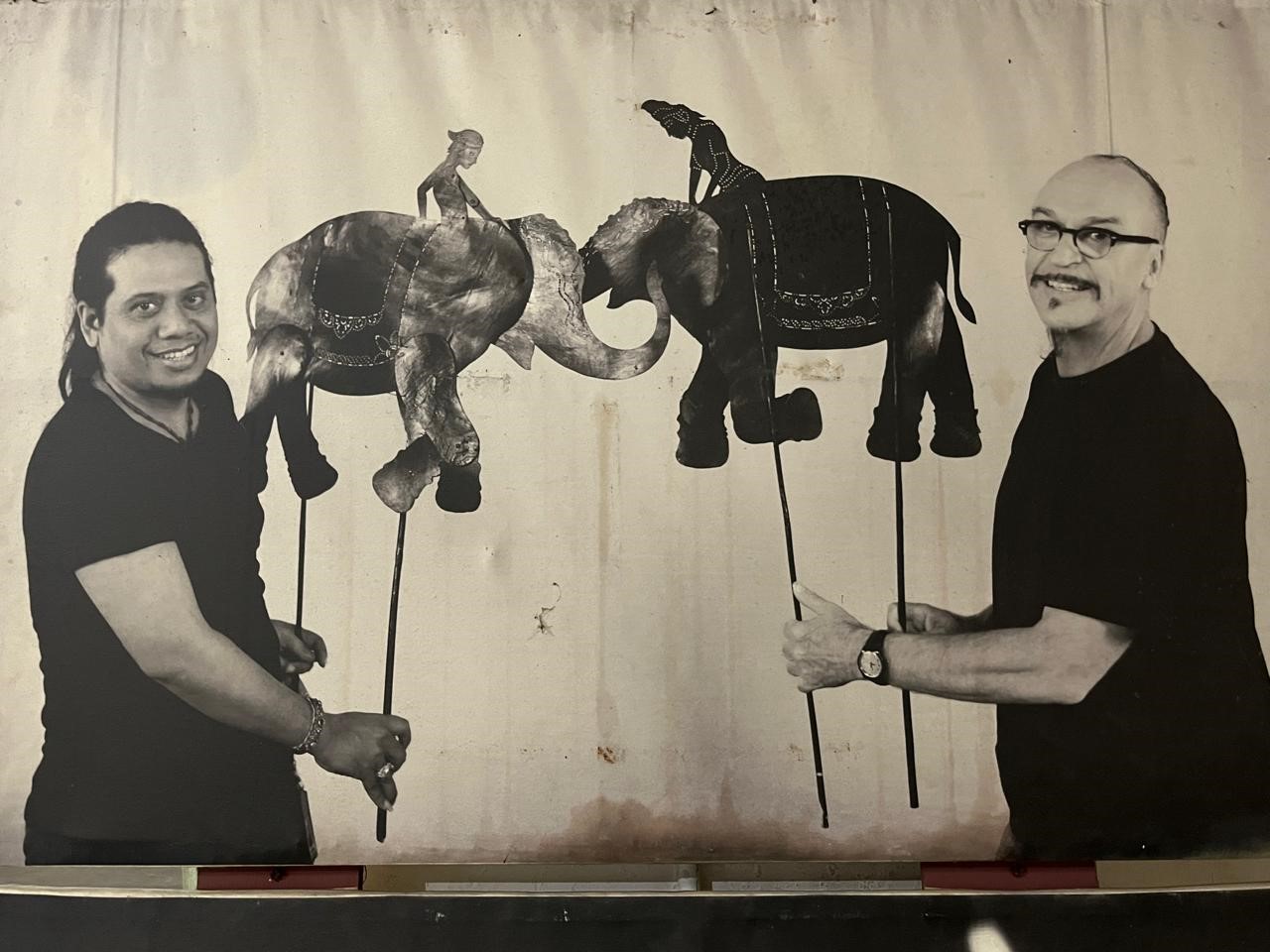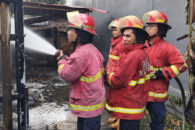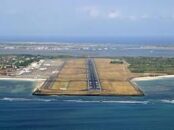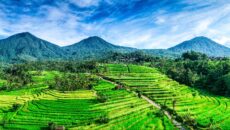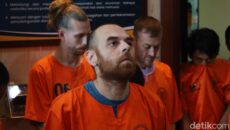About Peter J. Wilson
Australian Peter J. Wilson is acknowledged not only in Indonesia but also internationally as a creative genius via his more than five decades of association with spectacular stage productions and public extravaganzas. A man who considers both Bali and Australia as his home, he initially studied accountancy but also pursued modern dance and mime. A puppeteer since 1975, Peter was a founding member of the Handspan Theatre Company (1977).
Decades of directing, performing, and touring professionally laid the groundwork in 2004 for the co-authorship with Geoffrey Milne of a book on contemporary Australian puppetry, The Space Between – The Art of Puppetry and Visual Theatre in Australia (Sydney, Currency Press, 2004).
A talented performer and educator, Peter Wilson pioneered the Post-Graduate Diploma and Master’s in Puppetry Program at the Victorian College for the Arts in Melbourne, which operated from 2004 to 2009.
Between 2007-2009, Peter Wilson directed Colours of Malaysia. In Bali, He directed Bali Agung (Bali Safari and Marine Park, Bali, 2010) and was director of puppetry for How to Train Your Dragon (Arena Spectacular – Global Creatures & DreamWorks Animation 2012), King Kong (Global Creatures, 2013), Cho Cho San (National Theatre China, Playking Productions and The Melbourne Arts Centre, 2013), and was director for the Cricket World Cup 2015 Opening Ceremony.
He was also associate director and puppeteer for The Theft of Sita, a large-screen shadow play inspired by Balinese Wayang Kulit, which had a contemporary environmental message. It was commissioned by the Adelaide Festival (2000), directed by Nigel Jamieson, and included a Balinese dalang, I Made Sidia. Well received by critics and the public, The Theft of Sita toured Europe and New York in 2001.
In 2000, he directed puppetry segments for the opening of the Sydney Olympic Games, the 2006 Commonwealth Games in Melbourne, and The Asian Games in Doha. He has directed puppet productions in China, Malaysia, Japan, and Indonesia.
Bali Update wishes to express its sincere thanks to Peter J. Wilson for the following contribution “I Made Sidia and Peter J. Wilson – A Shared Creative Partnership.”
MADE SIDIA & PETER WILSON – ACROSS CULTURES
Contributed By Peter J. Wilson
Over the past 30 years, my creative relationship with the Balinese master puppeteer I Made Sidia has blossomed into a unique and enduring collaboration. Our shared passion for storytelling, ritual, and theatre has taken us across continents, across cultures, and into a deeply rewarding artistic friendship that continues to evolve. We are both dalangs (puppeteers), writers, teachers, and directors.
My fascination with Bali began in the early 1980s when I traveled to Indonesia to learn more about Wayang Kulit – the traditional shadow puppetry of the archipelago. The depth of ritual, the integrity of form, and the sheer theatricality of Balinese performance ignited something profound in me. I knew then that I wanted to build lasting creative connections with artists from this culture.
Like my own fascination with Balinese puppetry, Made Sidia has long held a deep curiosity about puppetry traditions beyond Indonesia. Traveling with his father to various European countries early in his career, he was exposed to a wide range of puppetry styles—an experience that expanded his creative vocabulary and inspired new ways of thinking about performance. These encounters planted seeds for future innovation. Over the years, he was also invited to the United States and several countries across Asia, where he deepened his appreciation for Western puppetry techniques and storytelling forms. These international experiences awakened in Made a strong desire to explore how traditional Balinese puppetry could converse with, and even influence contemporary global practices. This openness has enriched his artistry and made our collaborations all the more dynamic.
Our first major collaboration came in the late 1990s when I was in Bali developing a new theatrical concept with Australian director Nigel Jamieson and composer Paul Grabowsky. We were looking for a dalang and musicians to help shape a cross-cultural work. That’s when I met Made Sidia. His depth of knowledge, clarity of his Balinese performance, and generosity of spirit struck me immediately.
That project became “The Theft of Sita” – a bold, contemporary reimagining of the Ramayana. Both Made and I performed as puppeteers in the production, but it was his guidance and deep cultural insight that gave the work its true heart. His support in maintaining the spiritual and artistic integrity of the Wayang Kulit tradition was essential. He taught us the structure and nuances of the form—the histories of the characters, their symbolic roles, and how they fit into the larger cosmology of the Ramayana. His presence ensured that what we were creating wasn’t just inspired by Balinese tradition—it was rooted in it.
The show premiered in Adelaide and went on to tour internationally for three years. During that time, as part of a close-knit team of four puppeteers, our bond deepened. We weren’t simply co-performers—we were learning each other’s creative languages, discovering common ground between our cultures, and building the foundation for what would become a lifelong artistic dialogue. That project marked the beginning of something far greater than a single show: it sparked a shared journey of collaboration, trust, and mutual inspiration that continues to this day.
In 2004, Made visited Melbourne to lead a series of masterclasses at the Victorian College of the Arts (VCA), where I was teaching. He introduced students to the world of Balinese masks, Wayang, and storytelling. His presence was transformative—he opened a new door for young performers, offering them a living connection to ancient forms, charged with fresh energy and meaning. Over six weeks, his residency culminated in an end-of-semester performance: a 25-minute shadow play exploring moments from the Ramayana, woven into the student’s final-year showcase. It was a triumph—a testament to his artistry and generosity. Even now, two decades on, I meet students who speak with deep reverence for the impact of those teachings. Made left a lasting impression—one not just of craft, but of spirit.
Then in 2009, while I was in Bali, Made and I began conversations that would lead to our most ambitious work to date: Bali Agung: The Legend of Balinese Kings. Commissioned by Bali Safari & Marine Park, it would become a spectacular fusion of traditional performance and theatrical storytelling—featuring over 150 performers, live animals, puppetry, and a mix of traditional and contemporary music.
I was staying at Made’s home when he invited me to the Safari Park to see a short piece based on the Ramayana. After the performance, he gestured toward a large green shed—an empty structure intended to become a theatre. Inside, we found a dusty concrete bowl of a space, raw and waiting for purpose. We stood in that space and dreamed. Back at his sanggar that evening, Made shared the story of King Jaya Pangus—a tale deeply familiar across Bali, yet largely untold on a grand stage. Something sparked. I sat down and scribbled six scene ideas—just for fun, just to see what might be possible. Made’s eyes lit up.
A few days later, Made introduced me to Hans Manansang, the general manager of the park, who was instantly taken by the vision. Within weeks, he and the park’s leadership flew to Australia. I had assembled a creative team just in case things might move forward – contracts were signed to bring Bali Agung to life in mid-2010 on the Bali Theatre Stage.
Made brought the spiritual and cultural depth of Bali—his understanding of tradition, ceremony, and nuance became the soul of the piece. I brought the scaffolding—the structure, the staging, the direction, the narrative flow. Together, we wove something that felt both ancient and fresh. At the very heart of the show was Made’s Balinese heart—the steady pulse that grounded the work and gave it authenticity.
Bali Agung has run for over 15 years and continues to resonate with audiences. It remains one of the most meaningful collaborations of my life—a meeting of minds, cultures, and dreams. The magic lay not just in the scale of the show, but in the trust and creative fire we shared.
BALI AGUNG BALI THEATRE 2010
We continued our creative journey through several productions at the Safari Park—The Tiger Show, The Elephant Show, and the immersive nighttime spectacular Afrika Fire. While each show explored a different theme, at their core was always a strong Balinese narrative thread.
Culture was never just decoration—it was the beating heart of everything we created.
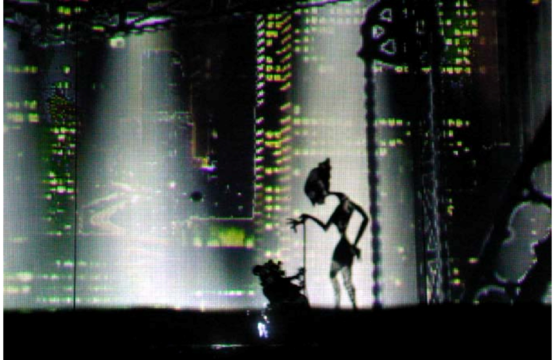
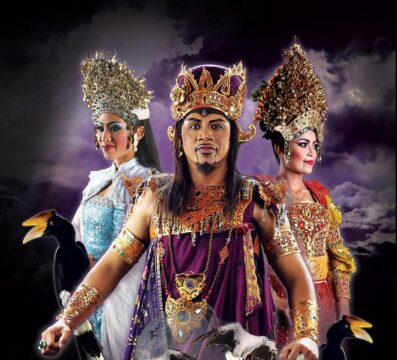
Beyond the stage, our collaboration deepened through training and exchange. I led workshops with students at his Sanggar Paripurna, where the energy and discipline of his troupe continually inspired me. At the same time, Made’s artistic reach extended far beyond Bali. Over the years, he traveled multiple times to Australia—teaching the intricacies of Wayang and Balinese masks across Darwin, Sydney, Melbourne, and Perth. His presence in those spaces brought something rare and essential—a living tradition shared with generosity and depth.
In 2016, Made and I traveled to Jakarta for Pearl of the South Sea, a marine theatre piece I had written for the newly opened Jakarta Aquarium. Made came on board to assist with choreography and puppetry training. While the show leaned into a Javanese myth and aesthetic, Made’s deep familiarity with the cultural layers of Indonesia—from Bali to Java and beyond—meant he could step into the world of the piece with ease and insight. His versatility and respect for each region’s traditions made him an invaluable bridge. Seven years on, the show is still running—a testament to the strength of the work and the creative foundation we laid together.
We also collaborated on the Opening Ceremony of the Bali Games in 2017—an ambitious fusion of local performance, storytelling, and ceremonial grandeur. Having worked on many large-scale arena events, I felt confident we could create something memorable. The challenge was finding the right subject—the cultural heartbeat of Bali—and shaping it into a visual narrative that could fill a stadium. This is where Made shone.
He introduced the concept of Dewata Nawa Sanga—the Nine Guardian Deities of Balinese Hinduism, each watching over a cardinal direction. It became the spiritual spine of the ceremony. Together, we built a show where every moment was rooted in Balinese mythology—gods and symbols came to life on an epic scale. Puppetry expanded across the stage, dancers emerged from every corner of the arena, and 150 men thundered in with a powerful Kecak. It was breathtaking.
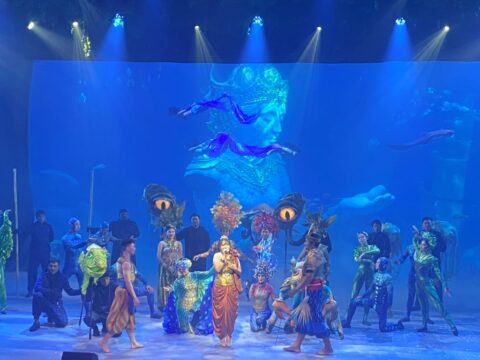
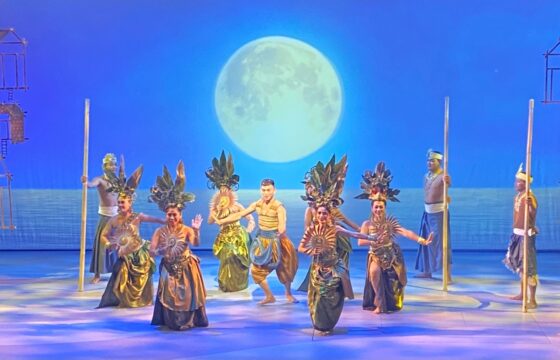
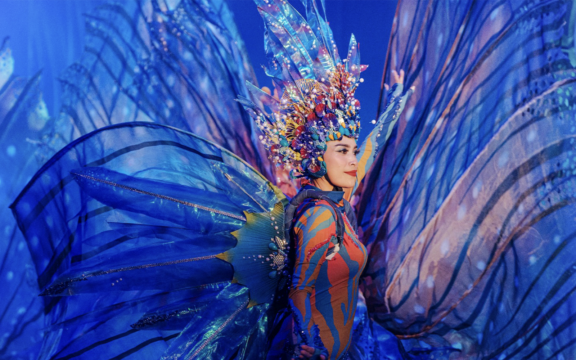
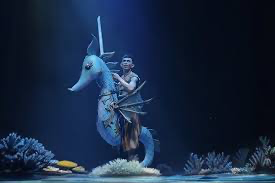
The Opening was a triumph—an arena filled with over 400 performers, celebrating athletes from Bali’s nine regencies. It was the perfect blend of Made’s cultural depth and my experience in theatrical staging. A vivid, living ceremony that honored both tradition and spectacle.
In 2023, I wrote and directed Varuna, an immersive underwater theatre experience created for the Bali Marine Park. Inspired by Baruna – the Hindu God of the Sea, the show explored the story of Varuna as protector of the oceans—a powerful force seeking harmony amidst rising tides and human disruption. The narrative follows a young boy’s journey beneath the waves, guided by sea spirits and creatures in his search for his mother. Along the way, he learns the delicate balance between nature and mankind.
The show blends myth, movement, music, and aquatic spectacle. Dance was at its core—contemporary choreography weaving through the watery world with grace and intention. Puppetry featured heavily too, but not in a traditional sense; we used new theatrical techniques to bring sea creatures to life—schools of jellyfish floating in dreamlike motion from above, their bodies lit from within; a luminous seahorse that carries the boy deeper into the ocean; and a wise old sea turtle who becomes his first companion on the journey. Each puppet, each movement, revealed a layer of the ocean’s story.
VARUNA BALI MARINE THEATRE 2024
As the boy dives further, he isn’t just exploring the sea—he’s searching for his lost mother and, unknowingly, his purpose. It’s in the deep where he begins to see the decay—plastic reefs, choking coral, shadowy figures of pollution monsters that feed off waste and chaos.

and Made Sidia
The playful crab he meets offers lightness, but even its world is threatened. Slowly, the boy realizes he’s been brought here for a reason—not just to search, but to protect. Guided by the creatures and the spirit of Varuna, the god of the sea, he begins to understand that only by facing the pollution monsters and cleansing the oceans can the balance be restored. It becomes a story of awakening—a call to action wrapped in beauty, puppetry, and powerful theatrical magic.
VARUNA BALI MARINE THEATRE 2024
Crucial to the production were the dalangs and performers from Made Sidia’s Sanggar Paripurna. Their training in traditional shadow and movement brought discipline and authenticity to the stage, but here, we worked together to adapt those traditions into a contemporary form — reimagining shadow play for a modern marine setting. Their contribution was extraordinary: grounded in heritage, yet open to reinvention. The result was a show that felt deeply rooted in Balinese performance, yet utterly fresh in its theatrical style. Varuna continues to run successfully, captivating audiences with its rich visuals, heart-driven storytelling, and the pulse of the sea.
What defines our partnership is not only the body of work we’ve created but also the deep trust and artistic alignment we’ve nurtured over three decades. Our collaboration has never been transactional—it’s been built on mutual respect, shared curiosity, and a deep commitment to listening and learning from each other’s cultural foundations. This trust allows us to take risks, experiment, and enter the creative unknown with confidence, knowing we are always working towards something greater than ourselves. We’ve never tried to fuse traditions for novelty’s sake—rather, we’ve sought to elevate each other’s forms through dialogue, genuine exchange, and a shared belief that when traditional and contemporary theatre meet with care, the result can be profound.
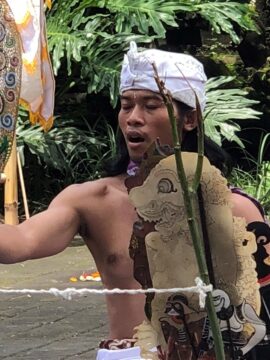
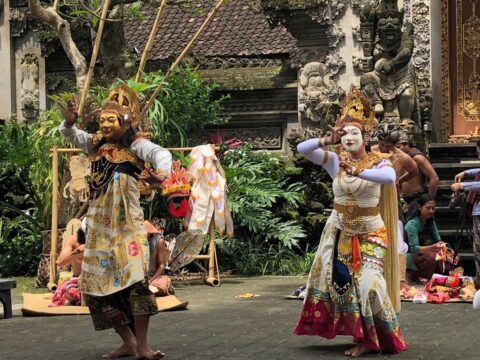
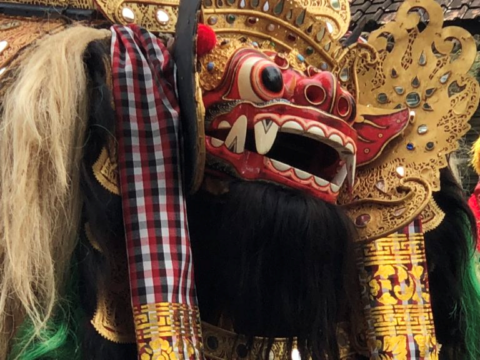
Over the years, we’ve discovered a common visual and theatrical language—not just in style, but in spirit. That language is built on rhythm, imagery, symbolism, storytelling, and the unspoken joy that comes when artists truly connect. We delight in the making—the building of worlds from shadow and light, from myth and metaphor. There is real joy in our process: the laughter in rehearsal, the sparks of new ideas, the satisfaction of watching an audience moved by something we shaped together. It has been a journey of creative companionship, and one we are committed to continuing.
Together, we will keep finding ways to bridge cultures, support emerging voices, and tell stories that matter—stories that resonate across time, across place, across generations. Our shared intention is to continue creating new work that honors tradition while also imagining bold, future-facing possibilities. We remain passionate about mentoring young artists, facilitating international dialogue, and showing that when artists from different worlds come together with humility and vision, the results can be extraordinary.
In essence, our collaboration is about honoring where we come from — while constantly imagining where we might go next. The journey isn’t over. It feels like we are just getting started.
In 2018, Made and I developed a new theatrical work titled Siwa Nataraja—a bold reimagining of the Siwa legend, approached from an entirely fresh perspective. Rather than retelling the story in the expected way, we explored what happens behind the veil of myth, delving into the unseen forces and inner realms of the narrative. The result was a visually rich, high-energy performance that burst onto the stage of Puri Kantor in Ubud with color, movement, and ritual intensity. This production celebrated the heart of tradition while joyfully subverting its form — turning it on its head to create something uniquely spectacular. It was a fearless blend of reverence and innovation and stands as one of our most striking and adventurous collaborations to date.
Related Links
Bali Agung Show – Taman Safari Bali
Varuna Dining Theatre – Marine Safari Bali
Stay Informed on Bali Tourism-Related News: Subscribe to Bali Update

